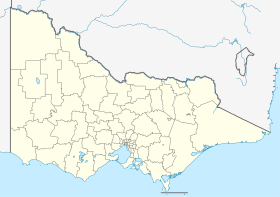Echuca
| Echuca | |||||||
|---|---|---|---|---|---|---|---|
 Murray River near Echuca with paddle steamer |
|||||||
|
|||||||
|
|||||||
|
|||||||
|
|||||||
|
|
|||||||
| Echuca | ||||||||||||||||||||||||||||||||||||||||||||||||
|---|---|---|---|---|---|---|---|---|---|---|---|---|---|---|---|---|---|---|---|---|---|---|---|---|---|---|---|---|---|---|---|---|---|---|---|---|---|---|---|---|---|---|---|---|---|---|---|---|
| Climate diagram | ||||||||||||||||||||||||||||||||||||||||||||||||
| ||||||||||||||||||||||||||||||||||||||||||||||||
Echuca is a port city on the Murray River in Victoria, Australia , just across from its sister city Moama . It uses its former relative size as a cargo port for tourism today. The name of the city of 13,000 inhabitants means “meeting of the waters” in the Aboriginal language. In Echuca, two smaller rivers (Goulburn River and Campaspe River) flow into the Murray River, the largest river in Australia.
A kind of living exhibition about the heyday of the city allows an insight into the conditions at the time of the Victorian gold rush and an impressive collection of old, partly beautifully restored paddle steamers is used for tourist trips.
history
Origin and foundation
Echuca was founded by Henry Hopwood, a former convict. In 1850 he bought a small ferry on the Murray River. A small settlement developed, initially under the name Hopwood's Ferry . Later the village was named Echuca. The post office under the name Hopwood's Ferry opened in 1854 and was renamed Echuca on January 1, 1855.
The European settlers treated the indigenous people relatively well, but their contact with the whites changed their lives significantly. By the end of the 1820s they had been significantly decimated by smallpox , and around 1850 they discovered European goods such as bread, tobacco and, above all, alcohol. They were marginalized and dwelt on the banks of the Murray River. Occasionally they participated in the white economy as fishermen or farm laborers, or they sold possum fur blankets that they had made themselves. Within a few decades, their lifestyle had changed significantly from that of their ancestors.
In the 1870s, Echuca became known as Australia's largest inland port. Since this city is located on Melbourne's closest point on the Murray River, it developed not only into an important river port, but also a railway junction. Paddle steamers docked at the 400 meter long quay and goods were unloaded that were then transported on to Melbourne by rail. Wool, wheat, other grains, livestock and wood were the main cargo. The quay was added to the list of historically important places in Australia.
Industrialization led to a rapid increase in the population up to 15,000. The city is said to have had over a hundred pubs and hotels. Around 1870 an iron bridge was built over the Murray River.
Decline
The expansion of the railroad and road networks and the frequent low water levels of the Murray River meant that Echuca lost its importance. In the 1890s, the paddle steamers' fleet was decreasing again. An economic depression and the collapse of several banks finally ended Echuca's role as an important trading center and the population moved away. Today Echuca lives from tourism.
Attractions
Njernda Aboriginal Cultural Center
Located in the old courthouse on Law Place, this museum shows the way of life and art of the Aboriginal people. The building also houses a museum shop that sells Aboriginal handicrafts .
Port of Echuca
The old port with its dock and its two historic buildings can be explored with one ticket. Also included is a visit to an escape tunnel for black markers in the Star Hotel , who escaped the police in this way.
There are other places of interest near the port. The Red Gum Works , a historic sawmill, the Coach House with its carriage collection and Sharp's Macic Movie House with its vintage slot machines and old films.
World in Wax
It's the Madame Tussauds by Echuca: the World in Wax. Almost 70 wax figures, from the Pope to the “Crocodile Dundee” hero Paul Hogan , can be admired here.
National Holden Motor Museum
The only Holden automobile museum in Australia is on Warren Street near the Port of Echuca. In changing exhibitions in the private museum, Holden vehicles from 1948 to the present day can be viewed.
sons and daughters of the town
- Travis Fimmel (* 1979), Australian model and film actor
Web links
Individual evidence
- ↑ Australian Bureau of Statistics : Echuca ( English ) In: 2016 Census QuickStats . June 27, 2017. Retrieved April 18, 2020.
- ↑ Bureau of Meteorology, Australia: Climate information Echuca. World Meteorological Organization, accessed April 6, 2012 .



